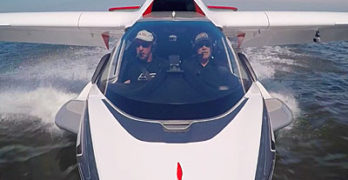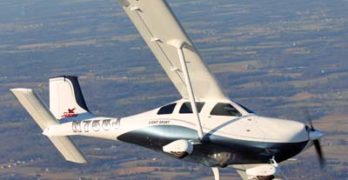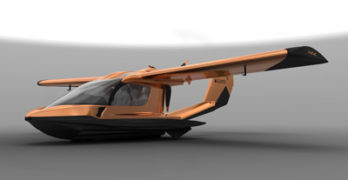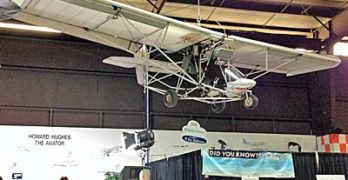Back in early 2014, Flying magazine online wrote, “There’s an old saying among pilots that ‘airspeed equals life.’ In other words, keep your speed up, and you’ll avoid stalling the wing during critical phases of flight, such as the base-to-final turn. But, that’s a misnomer since the stalling airspeed of a wing will change based on aircraft weight and load factor.”
Many ex-military pilots also insist AoA is a vitally important gauge. Air Force jet jocks are often shocked that civilian pilots are still flying based solely on airspeed.
FAA certainly caught the fever, proclaiming statements similar to this one: “Inadvertent stalls are implicated in almost half of the GA approach and descent accidents.” The implication is that AoA will cure this deathly problem.
Advanced Flight Systems was quoted as saying, “Nearly one-half of Experimental and over one-fourth of certified aircraft fatalities are the result of stalls and spins. The killer-turn from base to final is the leading culprit.”
Wow!
Search Results for : evolution
Not finding exactly what you expected? Try our advanced search option.
Select a manufacturer to go straight to all our content about that manufacturer.
Select an aircraft model to go straight to all our content about that model.
VPRs & More at Copperstate 2015 (Part 1)
Updated 11/5/15 with video at end …
We went. We flew (and flew). We shot video … lots of video. Videoman Dave’s dual hand held cameras got a workout as did our six Garmin VIRB cameras. We did more of our popular interviews but we also captured multiple angles on several aircraft as we continue to build our expanding library of VPRs or Video Pilot Reports.
Nearly always hard at work on terra firma, Dave went aloft (photo) to get some air and to capture aerial images. Dave took a seat in the twin-engined AirCam with company designer and boss, Phil Lockwood so you can see Copperstate 2016 from the air.
Honestly, I can hardly imagine how Dave keeps track of those hours and hours of video much less organize them into the productions you enjoy to the tune of 1.5 million minutes a month of viewing.
Gyroplanes and Autogyros … Same or Different?
(Images updated 9/2/15)
Are you intrigued by airplanes that spin their wings? Helicopters are out of the budget for most pilots but have you ever sampled a gyroplane? Whatever your answer, you should know that Rotax Aircraft Engines reports selling more 912 powerplants to gyro producers than to any other airplane segment. Most of those are sold outside the USA.
Americans like and do fly gyroplanes, of course. Most associate the type with the Bensen Gyrocopter, but the history record reveals its overseas start. Again today, gyros are predominantly a non-U.S. phenomenon, a fact LAMA is trying to change through its advocacy efforts to press FAA to reconsider the fully built SLSA gyro as once envisioned under the SP/LSA rule.
While most pilots can identify a gyroplane, they mentally picture an aircraft with the engine in the rear. That isn’t always the case, though.
How about the “odd” looking gyroplane pictured with this article, with its tractor engine?
DemoVenture 2015 — Flying at Oshkosh
Shows like Sebring and Midwest LSA Expo are known for being great places to demo fly a Light-Sport or light kit you may be considering to buy. They earned that reputation because it is typically much easier to fly at those lower-key, less crowded events than at giant shows like AirVenture. However, some companies make demo flying a mission at Oshkosh and this article covers three that delivered an exceptional number of demo flights.
Icon reported doing around 150 demonstration flights in the first public outing of the long-awaited LSA seaplane. Writers for aviation’s largest magazines got their private crack at the new bird beforehand … since returning from Oshkosh, I’ve seen A5 on the covers of Flying, AOPA Pilot, Sport Aviation, and Plane & Pilot. That’s an enormous splash. I can’t recall any single aircraft capturing all four titles in the same month, quite a credit to Team Icon for deftly executing such a major marketing push.
AirVenture Previews Continue as Opening Day Nears
We and many other journalists have arrived in EAAworld and are gearing up for another big event. Here are two aircraft announcements of interest and one avionics offering. More will follow.
Jabiru USA has news prices and new gear for their speedy line of kits and LSA. Jabiru USA Sport Aircraft is celebrating ten years in the Light-Sport Aircraft market by offering a new large-screen Garmin G3X Touch avionics package as standard equipment for its J230-D high-performance composite LSA while lowering the price of the fully-loaded aircraft to $119,900. The Australian-designed Jabiru J250/230 series has been flying in the U.S. since 2005 and is known for its speed, easy handling and large baggage capacity.
“By simplifying our overhead, we are now able to offer the new fully-equipped J230-D with the Garmin system for $119,900, a price cut of nearly $20,000,” said Jabiru USA general manager Pete Krotje.
Riding the Wave … Vickers’ Wave, That Is
As I’ve written a few times, I see a dichotomy in LSA designs. Landplanes appear to have entered a “mature” phase, where changes are incremental, evolutionary rather than revolutionary, if you will. I see nothing wrong with that. To the contrary, it speaks to an industry that knows where it is going and how to achieve design goals. Electric propulsion is still stirring things considerably (witness several recent articles here and elsewhere) but electric motors can work on landplanes or seaplanes.
To my view, it appears the lead in the most innovative design is being done in LSA seaplanes. Perhaps this was triggered by Icon and their A5. The California entry is handsome and well enough marketed to collect many orders. While finally coming to market A5 has been a decade in preparation. This left the door open for more highly innovative entries
Meanwhile existing designs such as Searey and Super Petrel have been much refined and have demonstrated meeting ASTM standards with Searey also achieving Chinese Type Design Approval.
Wings from the North Lift Many Trikes
I’ve been writing about very affordable aircraft•, specifically about Part 103 ultralight vehicles. I know some readers prefer speedier or fully enclosed aircraft. Those people are fortunate as many choices are available and, of course, I will continue writing about them frequently. However, many pilots in the USA and around the world do not have a budget for a magnificent carbon fiber personal aircraft that costs $150,000. Even among those who can afford such aircraft, I’m amazed at the renewed interest in these simplest of aircraft.
In addition, aircraft as shown in the nearby photos have seen considerable development since the early days of weight shift trikes. In my view, America invented these aircraft back in the late 1970s but as three axis ultralights developed, interest from American pilots drew away from weight shift and the best new ideas seemed to come from Europe, Australia or other countries. However, I now see the freshest developments coming from U.S.
Is Rev for You? …for Less Than $18,000?
UPDATE 5/10/15 – Rev Videos — Shortly after the following article was written, we posted two videos about Evolution’s new Rev. Part 1 shows you how fast the setup from trailer to flight goes and Part 2 gives more information, both featuring primary developer Larry Mednick. Enjoy! –DJ
Earlier I’ve written that the Part 103 ultralight sector seemed more vibrant than ever at this year’s Sun ‘n Fun. I admit a bias. I love Part 103 … the aircraft, the concept, I like flying single seat aircraft, and, hugely, I love that Part 103 deftly avoids most of the interference from government officials that tends to dominate so much of aviation worldwide. While certified aircraft have hundreds or thousands of pages of regulations they must follow, Part 103’s entire ruleset can be printed on the front and back of a single piece of paper. That’s fantastic!
Earlier a few folks reading my enthusiasm about Sun ‘n Fun 2015 exhibits of Part 103 machines voiced doubt that these machines can actually qualify — meeting the challenging empty weight of 254 pounds (278 if a parachute is mounted; more if floats are added); the max speed of 55 knots or 63 mph; the stall of 24 knots or 28 mph; the five gallons of fuel, and, well … that’s nearly it.
Sun ‘n Fun 2015: Part 103 Ultralights Are Hot!
Part 103 ultralight activity was not the news I expected to report from Sun ‘n Fun 2015, certainly not as my first report. After an intense week shooting video interviews at Sun ‘n Fun 2015, I am impressed to report that Part 103 is much more than alive and well. For those that may have missed this unique category, Part 103 ultralight vehicles (FAA’s deliberate wording) are single seat flying machines of varying description that need no medical, not even a pilot license, no N-number registration, and can be sold ready-to-fly. The entire FAA regulation for them can be printed on the front and back of a single piece of paper.
Adding to the charm of rarely having to interact with a government agency in order to have some fun in your airplane are a couple similar efforts in Europe. Germany has its 120-kilogram class (264 pounds) and England has its SSDR category (Single Seat De Regulated).
Glasair’s Merlin LSA Takes First Flight
What an amazing day! I heard of — count ’em — no less than three first flights. I don’t ever recall getting that kind of news in such a batch, but hooray! More airplanes to report on and more for customers to consider for their flying enjoyment. First up is the Glasair Merlin. I looked at the mockup of this new design at AirVenture 2014 (see video) and now she’s flying.
Glasair Aviation announced that their new Light-Sport Aircraft entry named Merlin “took its first flight through the skies above Arlington Municipal Airport Tuesday, April 7, 2015.” After many months of development work, the company put the new two seater through a regimen of preflight validation testing that included engine run-up, high-speed taxi, and ground roll lift off. Having completed this important set of tasks the team at Glasair watched as Merlin departed the surface with test pilot Grant Smith at the controls.
- « Previous Page
- 1
- …
- 10
- 11
- 12
- 13
- 14
- …
- 21
- Next Page »











